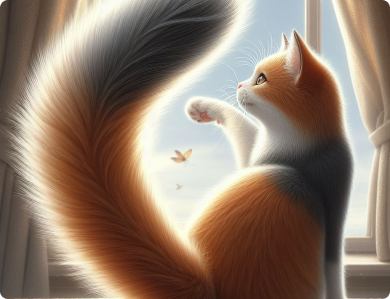Your cat’s tail can tell you a lot about what they’re focused on and how they’re feeling. By understanding their tail placements, you’ll be able to detect their mood more easily and either let them be or give them some pets.
Tail positions
- Straight and tall tail: indicates that your cat is open to interacting and feeling confident and comfortable
- Horizontal tail: If the tail is parallel to the ground, they’re likely curious and exploring what’s around them
- Low tail: Your cat may be cautious and unsure about something. This shows that they’re alert but not yet aggressive
- Tail between legs: This means your cat is scared and anxious. They could be feeling threatened
Tail positions
Tail puffed up:
When you see a cat’s tail puffed up this means they’re stressed, fearful and defensive. This position is often referred to as a bottlebrush tail. Cats fluff their tails to appear larger to others.
Tail lashing or flicking:
Usually when a cat’s tail is thumping against the ground or thrashing, your cat is feeling annoyed, irritated or overstimulated. Give your cat some space as this may be the first warning they give before they bite or scratch
Tail in a question mark:
Your cat is showing that they are interested and curious and generally happy.
Slow tail swishing:
You may notice that when you’re playing with your cat and they’re focused on an object, their tail swishes a little. This shows that they’re about to pounce.
Tail wrapped around them when sitting: When your cat is sitting and their tail is wrapped, they may be feeling cautious.
Being able to decipher your cat’s tail positions can be valuable for better understanding your cat, their emotions and their needs. While tail language provides essential insights, there are also other cues like eyes, ear position, posture, and vocalizations, that will help you get a holistic picture of how they’re feeling. By paying attention to body language, you’ll be able to deepen the bond with your feline baby and be in tune with their well being.

